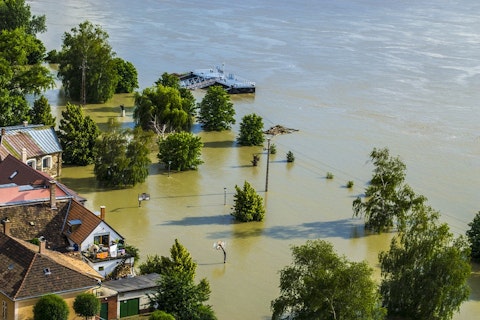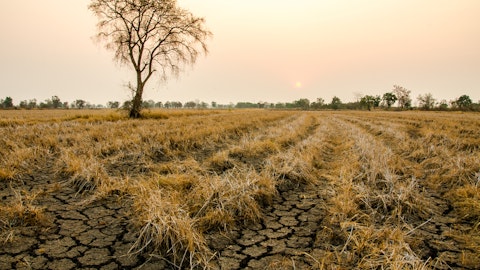In this article, we take a look at the 15 countries with the most climate refugees in the world. If you would like to skip our detailed analysis, you can directly go to the 5 Countries with the Most Climate Refugees in the World.
Displaced or Refugees: The Big Question
UNHCR reported that of all the internal displacements that took place in 2022, more than half were triggered by climate-related disasters. As the link between climate risk and human displacement grows, there’s a widespread concern that the phenomenon might trigger massive migrations from the Global South to the Global North. However, UNHCR states that the majority of the people forced to move due to climate risk tend to shift within their own countries. The IDMC Global Report on Internal Displacement mentioned that climate-related disasters triggered 32.6 million internal displacements in 2022. Furthermore, UNHCR reported that 70% of all refugees shift to neighboring countries in an attempt to stay close to family, so affected individuals are less likely to move longer distances. Because most climate displacements happen within the state borders, ‘climate refugee’ is not a term officially recognized by international law.
Internal Displacements and Climate Change in 2022: Breaking World Records
According to the IDMC Global Report, a total of 71.1 million people were living in internal displacement when 2022 ended, which was the highest number ever recorded and a 20% increase in just a year. The La Niña weather phenomenon was one of the biggest causes behind climate-related displacements, triggering 2.1 million movements across Somalia, Ethiopia, and Kenya. Even though the event is generally triggered every 3-5 years, 2022 saw it happen for the third consecutive year, showcasing the dwindling state of climate around the globe. The event also generated record levels of flooding in Pakistan, Nigeria, and Brazil, impacting two separate clusters of countries differently.
Overlapping Issues – The Wider Impact
The IDMC Global Report also touched upon how internal displacement aggravates food insecurity. According to their assessment, three-quarters of the countries where food security was assessed had internally displaced populations. The highest number of food-insecure people were found in DRC, Yemen, Nigeria, Afghanistan, and Ethiopia. These countries collectively house over 26 million Internally Displaced Persons (IDPs), which makes up a third of the global total. The Horn of Africa also faced its longest and most severe drought in 2022, showcasing extreme water scarcity in the region.
The Carnegie Endowment for International Peace has reported on the link between economic development and climate change, stating that during the second half of the twentieth century, a country whose temperature rose by 1°C reported a 1.4% fall in per capita income on average. In April 2021, the Swiss Re Insitute published a report titled “The Economics of Climate Change: No Action Not An Option.” According to its findings, the global economy could lose 10% of its value due to climate change by 2050. However, if no policy actions are taken and temperatures rise by 3.2°C, 18% of global GDP could be lost in the same duration. Even if all countries meet the Paris Agreement targets, the global economy will still face a contraction of 4%. In light of this information, you can check out the 22 Countries Most Likely To Survive Climate Change and the 25 Cities with the Best Climate in the World Year Round.
Companies Addressing Climate Resilience and Food Security Challenges
As local communities struggle immensely due to the growing impacts of climate disasters, companies offering adaptation and resilience solutions achieve paramount importance in tackling this issue. Xylem Inc. (NYSE:XYL) is a water technology provider that works on achieving water sustainability and combating water scarcity in more than 150 countries around the world. On February 29, 2024, Xylem Inc. (NYSE:XYL) reported that in 2023, along with its partners, it supported 1,000 NGOs in 56 countries to deliver WASH access and education for local communities. Xylem Inc. (NYSE:XYL) also provided humanitarian aid response to 30 climate disasters, including the provision of pro-bono emergency water treatment solutions to disaster-struck countries including Chile, Türkiye, Libya, and Morocco. The company’s 2025 sustainability goals include providing clean water and sanitation for at least 20 million individuals.
Archer-Daniels-Midland Company (NYSE:ADM) is an agricultural processing company working on innovative projects to increase crop yield and decrease food waste in low-income countries, battling food scarcity. In 2022, Archer-Daniels-Midland Company (NYSE:ADM) spent $120,000 on three different projects in India, Bangladesh, and Indonesia to combat post-harvest agricultural losses. Each of these projects were aimed at developing strategic partnerships and enabling farmers to increase the efficiency of their farming methods. On November 21, 2023, Archer-Daniels-Midland Company (NYSE:ADM) launched a Regenerative Agriculture Program in Brazil, intending to build 120,000 regenerative hectares by 2027. The program will enhance farmer productivity through three primary practices: fertilizer use efficiency, no-till farming, and covered soil crops.
Corteva, Inc. (NYSE:CTVA) researches crop protection and seed growth management in order to make farming more efficient. The company is currently collaborating with several other partners to create biofortified sorghum as a means of tackling nutrient deficiency in 300 million people across Africa. Like Archer-Daniels-Midland Company (NYSE:ADM), Corteva, Inc. (NYSE:CTVA) has also teamed up with Brazilian farmers by providing them with drought-tolerant soybeans as protection against the water stress common across several parts of the country. By developing these new technologies, companies like Corteva, Inc. (NYSE:CTVA) are playing their role in mitigating the food scarcity prevalent throughout Africa today.
Despite all these efforts, climate risk continues to be a significant hurdle for almost every country in the world today. Keeping that in view, let’s look at the 15 countries with the most climate refugees currently. You can also check out 44 Countries With Hot and Wet Equatorial Climate.

15 Countries with Most Climate Refugees in the World
Our Methodology
For the purpose of this article, we primarily looked at internal displacements that occurred in 2022 due to climate disasters. This is because, as corroborated by UNHCR data earlier, most climate-related displacements happen within the country, and there is no particular index yet that could quantify cross-border climate-induced migrations across the globe. The Internal Displacement and Monitoring Centre’s Global Report on Internal Displacement was used to source the displacement numbers. Further insights from the report have been added for each country. In order to provide further context, we have mentioned the 2023 Net Migration Rate (migrants per 1,000 people) for each country, as reported by the CIA. Our rationale is that out of all the migrants that leave a country, some may do it due to climate risk. A negative value for the net migration rate is indicative of more outflows than inflows. We have also stated each country’s climate vulnerability based on the 2021 ND-GAIN Index scores. This delivers information regarding the general climate risk a country is facing. The higher a country’s score, the more vulnerable it is to climate change.
Based on this methodology, here are 15 countries with the highest number of climate refugees worldwide, ranked in ascending order of the internal displacements by disaster, primarily.
15 Countries with the Most Climate Refugees in the World
15. Colombia
Internal Displacements by Disaster: 281,000
ND-GAIN Score: 0.414
Net Migration Rate: -1.9
In Colombia, heavy floods caused by massive rainfall led disaster-related displacements to be higher than they had been in a decade. Most of the displacements took place in the Northern regions of Sucre and Bolívar, especially during the month of May when the rainy season peaked.
14. Indonesia
Internal Displacements by Disaster: 308,000
ND-GAIN Score: 0.440
Net Migration Rate: -0.7
Indonesia is 14th on our list of countries with the most climate refugees, as it faced several climate-related disasters throughout the year. Geophysical hazards like earthquakes, tsunamis, and volcanic activity were the most prominent causes behind the internal displacements in Indonesia. The Cianjur earthquake on November 21, 2022, triggered 115,000 displacements alone.
13. Vietnam
Internal Displacements by Disaster: 353,000
ND-GAIN Score: 0.475
Net Migration Rate: -0.2
Based on the high risk of heavy storms, governmental authorities in Vietnam set up several early warning systems and evacuation protocols. 96% of the country’s total disaster displacements were a result of the early evacuations before Typhoon Noru. This is how Vietnam became one of the countries with the most climate refugees globally.
12. Democratic Republic of Congo (DRC)
Internal Displacements by Disaster: 423,000
ND-GAIN Score: 0.564
Net Migration Rate: -0.6
The 2022 displacement figures from the Democratic Republic of Congo showcased a 48% increase from 2021. According to IDMC, DRC also hosts one of the world’s largest food-insecure populations, emphasizing the overlap of these two issues. Floods, heavy rains, and landslides were the causes behind the weather-related displacements in the country.
11. South Sudan
Internal Displacements by Disaster: 596,000
ND-GAIN Score: 0.604
Net Migration Rate: 20
Due to recurring floods and conflict in the area, only 4% of the land is cultivated in South Sudan. Whatever little area is cultivated was destroyed by widespread flooding in 2022, which triggered severe food insecurity in the country. By the end of November 2022, it was reported that 54% of the population was facing acute food shortage. The total number of displacements in 2022 was the highest recorded number for South Sudan ever. South Sudan is placed 11th among the countries with the most climate refugees in the world.
10. United States
Internal Displacements by Disaster: 675,000
ND-GAIN Score: 0.309
Net Migration Rate: 3
Wildfires were the biggest cause of internal displacements in the United States in 2022. The ND-GAIN Index doesn’t classify the US as a climate-vulnerable country; however, the increasing number of wildfires does make it one of the countries with the most climate refugees in the world.
09. Brazil
Internal Displacements by Disaster: 708,000
ND-GAIN Score: 0.374
Net Migration Rate: -0.2
In 2022, Brazil and the US collectively accounted for two-thirds of the total disaster-related internal displacements in the Americas. Heavy storms, rains, and landslides were the main contributors to the issue. The country faced over 1,300 climate disasters in the year, each leading to displacements of some level, which collectively added up to 708,000 individuals, the highest figure in over a decade.
08. Ethiopia
Internal Displacements by Disaster: 873,000
ND-GAIN Score: 0.547
Net Migration Rate: -0.1
According to the IDMC, Ethiopia is facing the worst drought in four decades, which makes it one of the countries with the highest number of climate refugees. The worst drought-related situation was recorded in the Somali and Oromia regions. Around 686,000 displacements were triggered by drought alone. These conditions also contributed to severe food insecurity in the country.
07. Somalia
Internal Displacements by Disaster: 1,152,000
ND-GAIN Score: 0.678
Net Migration Rate: -1.4
The ND-GAIN Index ranks Somalia as the most climate-vulnerable country in the world out of 185 states. The 2022 drought in the Horn of Africa also affected Somalia, which accounted for 1.1 million out of the 2.1 million drought-related displacements in the region. These conditions affected nearly half of the country’s population, making Somalia one of the countries with the most climate refugees.
06. Bangladesh
Internal Displacements by Disaster: 1,524,000
ND-GAIN Score: 0.531
Net Migration Rate: -2.9
In 2022, Bangladesh started to experience the impact of flooding even before the official monsoon season began. At least 482,000 displacements were triggered by the monsoon floods alone. The Cyclone Sitrang caused around a million displacements as well. Data reporting is a huge issue in Bangladesh because disaster reports only tend to be created for bigger hazards, which means many small-scale displacements go unreported. Bangladesh is ranked 6th on our list of countries with the most climate refugees in the world.
Click to continue reading and see the 5 Countries with the Most Climate Refugees in the World.
Suggested Articles:
- 15 Countries That Contribute The Most To Climate Change
- 30 Best Places to Live in the World for the Weather
- 15 Most Dangerous States for Natural Disasters
Disclaimer: None. 15 Countries with the Most Climate Refugees in the World is originally published on Insider Monkey.





